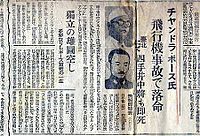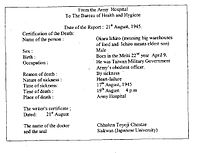- Death of Subhas Chandra Bose
-
The alleged death of Subhas Chandra Bose, the supreme commander of Azad Hind Fauj and Free India Legion in a plane crash in Taiwan on August 18, 1945, has long been the subject of dispute. There has been three Government of India sponsored commissions and numerous private investigations to find out if Subhas Chandra Bose had died in the plane crash. The third Indian commission that was appointed for enquiring into this concluded in its report tabled in parliament in May 2006, that Bose's death was staged to facilitate an escape to the USSR.
Contents
Introduction
Subhas Chandra Bose, a prominent leader of the Indian independence movement against the British Raj in India and a general of the Imperial Japanese army Tsunamasa Shidei were reported to be flying to Tokyo, Japan when the alleged plane crash occurred at Matsuyama aerodrome (now Songshan Airport) in Taipei, northern Formosa (now the Republic of China, or Taiwan). After cremation, Bose's ashes were taken to Japan and interred at the Renkōji Temple in Tokyo.[1] The news was withheld by the Japanese government for five days before it was announced by Japanese news agency Domei.[2] The Allied forces took the Japanese news as a ploy. The then Viceroy of India, Field Marshal Archibald Wavell, is reported to have noted in his diary that "I wonder if the Japanese announcement of Subhash Chandra Bose's death in an air-crash is true. I suspect it very much, it is just what should be given out if he meant to go underground."
The matter was looked into by several allied intelligence teams and soon holes in the Japanese version became apparent.
The findings of the intelligence teams seem to have not confirmed the Japanese announcement. For as late as October 1946, the Government of British India refused to confirm the death of Bose.[citation needed]
After India's independence, the matter was looked into by three official panels formed by the government of India following the public demands. These panels were: Shah Nawaz Committee, Justice GD Khosla Commission & Justice Mukherjee Commission of Inquiry. The Shah Nawaz Committee upheld the Taiwan crash version,[citation needed] as did the Justice GD Khosla Commission,[citation needed] whereas the Mukherjee Commission negated it.[citation needed]
However, it has also been alleged at various times that the Indian government and political leadership was aware that Bose may have been alive, and according to one theory, in captivity in Soviet Union,[3][4] but chose to ignore or actively collaborate to suppress this information after Independence.[5][6]
Shah Nawaz Committee
Main article: Shah Nawaz CommitteeIn April 1956, the Jawaharlal Nehru Government formed a committee headed by Shah Nawaz Khan. Khan had earlier risen to the rank of Lt Col in the Second Indian National Army, before he was captured by allied troops after the fall of Azad Hind and was one of the three charged with treason in the Red Fort Trial. He was thus seen as an appropriate person to head the inquiry. Two other members of the inquiry commission were SN Mitra and Suresh Chandra Bose, Bose's elder brother. The committee's report that Bose had indeed died in Taipei became disputed due to several reasons. The most important among them was the dissentient report of Suresh Bose. Suresh Bose refused to agree with the findings of his colleagues and accused them and the Government of India of trying to coerce him into agreeing with their views.
In mid 1990s the released archives of Indian Political Intelligence proved conclusively that Bose was killed in 1945. Since rumours were circulating that he was still alive, Indian Political Intelligence arranged for Military Intelligence in New Delhi to investigate the matter. Captain Turner of the War Crimes Liaison Section in Taiwan(formerly called Formosa) was put on to the case and he managed to locate the last person to have seen Bose alive. This was Captain (Medical) Taneyoshi Yoshimi, who was under arrest in Stanley Gaol. He gave a statement that resolved the matter: ‘I personally cleaned his injuries with oils and dressed them. He was suffering from extensive burns over the whole of his body, though the most serious were those on his head, chest and thighs. During the first four hours he was semi-conscious...he murmured, and muttered in his state of coma, but never regained consciousness. At about 2300 hrs he died. I injected Formalin into the body and also had the coffin partly filled with lime.’ The coffin was then taken away and Bose's body was cremated.[7]
Mukherjee Commission
Main article: Mukherjee CommissionIn 1999, following a court order, the BJP led Indian government formed Mukherjee Commission of Inquiry. It was headed by Justice (rtd) MK Mukherjee of the Supreme Court of India. The commission perused hundreds of files on Bose's death drawn from several countries and also visited Japan, Russia and Taiwan.
Overturning the findings of previous panels, this commission's findings were that the news of Bose's death in Taipei were a cover-up for his escape to the USSR. The Commission, however, stated that they could not confirm Bose's presence in the USSR for want of evidence.
On the question of whether the sanyasi of Faizabad (Bhagwanji) was (or not) Bose incognito, Justice Manoj Kumar Mukherjee stated in his report that the question "need not be answered" as there was no clinching evidence to prove it.
The Mukherjee Commission submitted its report to Indian Home Minister Shivraj Patil on November 8, 2005. The report was tabled in the Indian Parliament on May 17, 2006. However, the Congress Party led Indian Government rejected the findings of the Commission.[8]
Bose mystery in contemporary India
Main article: Mission NetajiMission Netaji is a Delhi-based Indian non-profit trust that conducts research on Subhas Chandra Bose's disappearance. Some documents the organisation has dug out have information connected to Bose's disappearance. This led to more documents that remain classified.[9] Several Indian ministries, including the Indian Prime Minister's Office, have refused to make public the documents under the Right to Information Act campaign launched by Mission Netaji, on the ground that their disclosure will affect India's relations with foreign countries.[10]
References
- ^ Mitchell, Jon, "Japan's unsung role in India's struggle for independence", Japan Times, 14 August 2011, p. 7.
- ^ "Reported Death of Subhash Bose". The Hindustan Times. August 25, 1945. http://www.hindustantimes.in/news/specials/Netaji/images/a7.gif. HT Archives.
- ^ "Radhakrishnan met Netaji in Moscow, says witness". The Hindustan Times. November 17, 1970. http://www.hindustantimes.com/news/specials/Netaji/images/nov_17_70.gif. Retrieved August 11, 2006.
- ^ Hindustantimes.com
- ^ "Gandhi, others had agreed to hand over Netaji". Hindustan Times. January 23, 1971. http://www.hindustantimes.com/news/specials/Netaji/images/jan_23_71.gif. Retrieved August 11, 2006.
- ^ "Interview with Capt. Lakshmi Sahgal". The Tribune (India): Spectrum Suppl Sunday. June 12, 2005. http://www.tribuneindia.com/2005/20050612/spectrum/main1.htm. Retrieved August 9, 2006.
- ^ Outlookindia.com
- ^ "Fate of Indian war leader thrown into doubt by new report". The Guardian (London). May 18, 2006. http://www.guardian.co.uk/india/story/0,,1777155,00.html.
- ^ "Netaji's ashes still in Renkoji temple". The Hindu. March 8, 2007. http://www.hindu.com/thehindu/holnus/002200703080916.htm.
- ^ PMO refuses to furnish data on Netaji
Reports submitted by various commissions
External links
- Bhaumik, Subir (2005-02-04). "Taiwan rejects Bose crash theory". BBC News. http://news.bbc.co.uk/1/hi/world/south_asia/4236189.stm. Retrieved 2008-08-05.
- Japanese pictures of the reported crash in Taipei
- Amartya Sen goes by Anita Pfaff's view
- 'I saw Subhash Chandra Bose's burnt body'
- ‘Govt has destroyed evidence about Netaji's death’
- RTI makes Netaji rise from 'ashes'
- R&AW has no information on disappearance of Netaji
- PMO refuses data on Netaji despite RTI appeal
- Hindustan Times probe
Subhas Chandra Bose Family 
Education Events Azad Hind · Azad Hind Dal · Azad Hind Radio · Forward Bloc · Greater East Asia Conference · Indian Independence movement · Indian Independence League · Indian National Army · Indian National Congress · Indische Legion · Jai Hind · I-29 · U-180 · Special Bureau for India · Surrender of JapanAssociates IndiaAbid Hasan · C.R. Das · Raja Habib ur Rahman Khan · Gandhi · J.R. Bhonsle · Lakshmi Swaminadhan · Nehru · Rani of Jhansi Regiment · Rash Behari Bose · Shah Nawaz Khan · Bengal VolunteersGermanyJapanLegacy Death · Mission Netaji · Anuj Dhar · Bhagwanji · Political views · Renkōji Temple · Khosla Commission · Mukherjee Commission · Purna Swaraj · Shah Nawaz Committee · My enemy's enemy... · Netaji Subhas Open University · Netaji Bhawan · The Forgotten Hero (film)Categories:- Deaths by person
- Conspiracy theories
- Missing people
- Subhas Chandra Bose
Wikimedia Foundation. 2010.


